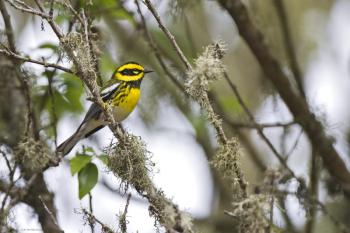Something unusual seems to be happening.
Here in Maine, it started off with the discovery of the western sibling species to our familiar eastern towhee, a spotted towhee, at Fort Foster in Kittery back in November. Spotted towhees essentially occupy the western half of the U.S. and Canada (only getting as far north as southern Canada) while eastern towhees occupy the eastern half. This was Maine’s first spotted towhee, and it has continued being seen into the New Year.
One found in Quebec, also in November, lingered at least into late December and one was seen in November in New Jersey as well.
Meanwhile, back here in Maine, the surprises really amped up in December. First, a Townsend’s warbler was found in Ogunquit hanging out with a small flock of warblers that not long ago would have been shocking in and of themselves for the time of year: Cape May warbler, Tennessee warbler, palm warbler, along with more expected “half-hardies”—yellow-rumped warblers and a pine warbler.
The Townsend’s warbler has continued to be observed into the New Year. The species is a West Coast relative of our familiar black-throated green warbler. They breed from Alaska south to Oregon, with some wintering along the Pacific Coast of the U.S. and some migrating farther south into Mexico to winter. There are a handful of previous Maine records, but the species is still a major rarity in the state.
Then, just this past week, the most astonishing sighting of them all was reported: a hepatic tanager was discovered in Stockton Springs. Hepatic tanagers are supposed to be in Mexico right now! And even in the breeding season, a birder would have to travel to Arizona or New Mexico to see one! This bird is not only a new species for Maine’s bird list but apparently is a first for anywhere in New England.
The origins of all of these birds are of a decidedly western U.S./northern Mexico flavor.
A look at bird sightings reported to eBird seems to show that this “west comes east” event is not just confined to Maine. Townsend’s warblers have been found in December in New Jersey (2), New York (an incredible four birds!), Quebec, New Brunswick, Nova Scotia, and Newfoundland. The one in Newfoundland is hanging out with a hermit warbler—another West Coast warbler that should be in Mexico for the winter!
Other “western birds” seen in the Northeast in December include black-throated gray warblers in New York and Nova Scotia; MacGillivray’s warblers in New York, New Hampshire, and Nova Scotia; and Bell’s vireo in Massachusetts, Rhode Island, and Nova Scotia.
One would have to assume that this is all interconnected with the major changes that are occurring with our weather as a result of climate change, though the exact nature of what’s happening and how will have to wait for others to study and add their conjectures.
Who knows what additional “western” oddities will be discovered here on the East Coast before all is said and done?
Jeffrey V. Wells, Ph.D., is a Fellow of the Cornell Lab of Ornithology and Vice President of Boreal Conservation for National Audubon. Dr. Wells is one of the nation's leading bird experts and conservation biologists. He is a coauthor of the seminal “Birds of Maine” book and author of the “Birder’s Conservation Handbook.” His grandfather, the late John Chase, was a columnist for the Boothbay Register for many years. Allison Childs Wells, formerly of the Cornell Lab of Ornithology, is a senior director at the Natural Resources Council of Maine, a nonprofit membership organization working statewide to protect the nature of Maine. Both are widely published natural history writers and are the authors of the popular books, “Maine’s Favorite Birds” (Tilbury House) and “Birds of Aruba, Bonaire, and Curaçao: A Site and Field Guide,” (Cornell University Press).


.jpg)





























